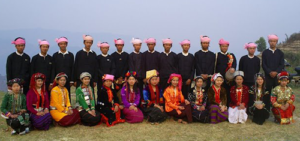 The Palaung people are one of the indigenous nationalities within the multi-national in the Union of Burma.
The Palaung people are one of the indigenous nationalities within the multi-national in the Union of Burma.
The Palaung are descended from Mon-Khmer from Mongolia passing China to Burma. The Palaung people have a long history and a strong sense of their unique identity.
They have their own language and literature, a distinctive traditional culture, their own territory and a self-sufficient economy.
The Palaung are predominantly Buddhist with less then ten percent animist and Christians.
The Palaung population is over one million, and most lives in the mountains of the northwestern Shan State. But large numbers also live in towns throughout the Southern and Eastern Shan State.
The customary lands of the Palaung people have lots of ruby and sapphire mines in the region, including the famous Moegok mine area, which has been cut out of Shan State and made a part of Mandalay Division by the Burmese dictatorship.
There are also many kinds of minerals in the Palaung lands including silver, zinc, gold and aluminum.
The Palaung tea is famous in Burma for the high quality that is grown in their upland farms.
They also grow a variety of temperate climate fruit crops such as apples, plums, avocados and pears, which are highly valued in the lowland areas.
Unfortunately, the Palaung people have not been able to live peacefully and tend their lands.
For centuries they have suffered offensive of their territories by Burmese army and other armies.
First, the Burmese kings tried to expand their imperial reach into Palaung lands and then became the British colonialists.
The Japanese imperialists in turn followed them, shortly after World War II. The Chinese nationalist Kuomintang moved into the lands of the Palaung where the Burmese army fought them.
The Burmese army declared a coup d’etat and established the Burma Socialist Programmed Party (BSPP) in 1962.
After that the Burmese army committed many injustices against the people, and the Palaung people along with many other nationalities, took up arms against them.
Then the BSPP regime encouraged gun running armed groups in the Shan State to become Ka Kwe Ye (people’s militia) to fight for the government against the indigenous nationalities armies.
At that year, General Ne Win took power over Burma. After this, the Burman army committed many injustices against the people, and the Palaung people, along with many other ethnic nationalities, took up arms against them.
In 1988 the Burmese government was reorganized and a dictatorship was formed called the State Law and Order Restoration Council (SLORC). SLORC put pressure on the Palaung people to force the Palaung State Liberation Army (PSLA) to negotiate with them.
First, they cut off communications between the PSLA and the Palaung villagers. They forcibly relocated villagers to sites near towns during the tea-harvesting season.
As a result, the villagers could not their harvest tea, and they suffered great difficulties from the loss of income. The PSLA feared the situation might worsen, so they were forced to negotiate with SLORC to provide relief to the Palaung people.
They reached a cease-fire agreement in 1991. Even with the cease-fire agreement, the State Peace and Development Council (SPDC) continue to commit human rights abuses in Palaung land.
Many Palaung have become “internal refugees” trying to survive in remote areas in the hills. Some fled to take refuge at the China border and in the northern border areas of Thailand.
In 1968 the Burma Communist Party (BCP), backed by the Chinese communists and also established bases in Palaung lands and fought against the Burmese.
In 1988 the dictatorship was formed and called itself the State Law and Order Restoration Council (SLORC). One year later, the BCP collapsed from internal problems and spilt into different ethnic armies. Some of these immediately made cease-fires with the SLORC.
In Shan State the independent non-communist indigenous armies opposed the dictatorship, but they faced confrontation of the SPDC troops.
The people who facing the threat of total destruction are the Pa-O army, some Kachin units based in the Shan State and some Shan armed forces made deals with the SLORC.
The Palaung State Liberation Army (PSLA) was left surrounded by a very large number of SLORC troops and had no choice so they had to sign a cease-fire agreement as well.
The Chinese-Shan warlord Khun Sa Loa Maw expanded his soldiers throughout the Shan State and forced many young Palaung joining his army that was attacked by the Burmese and sometimes also Wa cease-fire group.
Because of the long years of fighting, some Palaung villagers fled to more peaceful areas. Many become “internal refugees “trying to survive in isolated areas in the hills of Shan State.
Some, due to the brutal oppression of the Burmese armed forces and sometimes drug trafficking groups, fled to take refuge in the northern Thai border areas.
Some refugee settlements have been set up in Thailand for nearly 18 years.
Since opium king pin Khun Sa’s surrendered on 1st January 1996 to the SLORC, many other Palaung villagers who had lived in areas under Khun Sa’s control and whose family members had been forced joining his army have also fled to Thailand. Now there are about 5,000 Palaung refugees in the north of Thailand.
